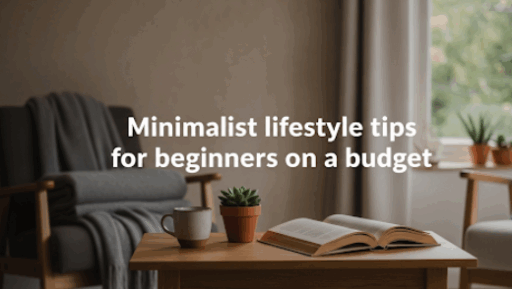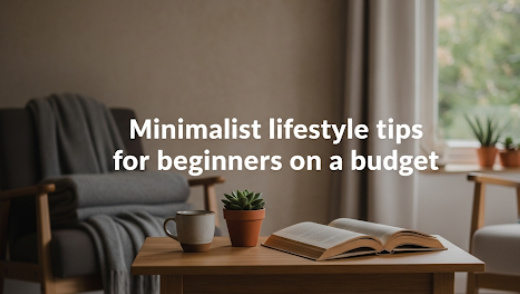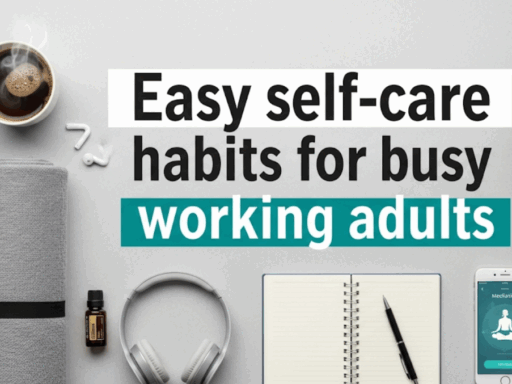Your Journey to Minimalist Living Simply — Steps for Beginners on a Budget
Less is not more spending less. In reality, living minimally can actually save you money — hundreds or even thousands of dollars a year, and possibly be the difference between coming home to a serene spot for relaxation and coming back to a chaotic one. For those sick of living in a mess, and an over-cluttered space eating away too much of your finances, this guide will walk you precisely through how to start with your minimalist journey without costing you an arm and a leg.
Minimalism is simple and that’s the most beautiful thing about it. Creating a minimalist home doesn’t mean you need to spend money on fancy organizing systems and designer furniture. What you will learn is how to make the most of what you have, select wisely for what to keep and find a sense of satisfaction owning less stuff that costs more but adds value.
Minimalism, but only if you are broke AF?!
The Hidden Costs of Clutter
Many people unknowingly store their excess possessions at a great expense to themselves, and they don’t even know it. Your items cost you beyond the immediate purchase price.
Cost includes:
- Storage space (rent or mortgage)
- Time to clean and maintain
- Emotional & mental energy to fold and organize
- Cost to replace something that breaks or wears out
These costs can start to pile on when you are living on a budget. This is where minimalism breaks the bank.
Money Opportunities Well Worth It
When you choose to live with the bare minimum, your finances instantly and long-term get a benefit:
Immediate Savings:
- Quit re-buying what you already have
- Reduce impulse purchases
- Lower cleaning supply costs
- Decreased storage needs
Long-term Benefits:
- Build stronger saving habits
- That money is better spent on quality not quantity
- Reduce stress-related spending
- Generate additional income by selling items you no longer use or need
Getting Started: The Zero-Cost Foundation
You Can Adopt Minimalism Without Spending a Penny
Before you buy one organizing product, figure out what minimalism is for your life and your budget.
- Define your “why” – is it financial freedom, less stress, or more time?
- Identify your ideal lifestyle — What are the things or activities that you care about the most?
- Begin to declutter one room at a time, every month not everything in one go
- Choose your pathway — The clutter bothering you most, make it yours
Create Your Free Minimalist Toolkit
Everything you already have that you need to start your minimalist journey:
| Item | Purpose | Cost |
|---|---|---|
| Cardboard boxes | Sorting belongings | Free (find some from grocery stores or use what you already have) |
| Permanent marker | Labeling boxes | Already owned |
| Phone camera | Taking before/after photos for inspiration | Free |
| Notebook | Tracking progress and goals | Already owned |
| Timer | Setting time-boxed decluttering sessions | Phone app |
Create a Room-by-Room Minimalist Makeover with a Shoestring Budget
Turn Your Bedroom into A Sanctuary of Serenity
After all, you should be able to enjoy bedtime. How to minimize this space without spending money:
The 30-Minute Bedroom Reset:
- Clear all available surfaces: nightstands, dressers, floors
- Use the “one week test” — if you haven’t worn it in one week, it belongs in a box
- Get the most out of your closet: turn all hangers backwards and turn them forward when you wear it
- Capsule wardrobe — Select 30–40 pieces that easily mix and match together
Free Bedroom Storage Hacks:
- Drawer dividers: empty shoeboxes
- KonMari folding: saves 50% space
- Under-bed storage: old suitcases with out-of-season items
- One in, one out with ALL clothing
Essentialism in the Kitchen: How to Cook with Less Stuff
There are more redundant items in kitchens than in any home. Make your kitchen streamlined to spend less on groceries and takeouts.
Essential Kitchen Items Only:
- A nice knife rather than a whole knife-block
- Pair of cutting boards (one for meat, another for vegetables)
- Measuring cups and spoons, set of one
- Good pots and pans (three: large, medium and small)
- Plates, bowls and cups for the family plus 2 more
Smart Kitchen Organization:
- Hang pots and pans on existing hooks or nails — organize vertically
- Multifunctional tools – Find items that have more than one use
- Uncluttered countertop – House only appliances that you use daily on your countertop
- Group by weight – Store heaviest products in middle sections
Budget-Friendly Kitchen Tips:
- Clean out spice rack and combine duplicate spices
- Re-purpose old containers like mason jars for food storage
- Use one drawer for all your cooking utensils
- Limit appliances to those you use weekly
Living Room: Carve Out a Space for Excellence
It is important that the living room of your house should reflect your interests, and also there should be a space maintained for the activities that interest you most.
Furniture Assessment Questions:
- Does all the furniture serve a clear function?
- Can you do the same function with fewer pieces?
- Seriously, when was the last time you used every one of your seats on a daily basis?
- What is going to occur in this room, and does your setup support that?
Free Living Room Improvements:
- Rearrange your current furniture — different layouts lend themselves to varying flows
- Declutter decorative items — Keep the things you truly like and that really speak to your heart
- Clear coffee tables & side tables — 1–2 functional/beautiful items only
- Organize entertainment center — Keep movies/games you will actually watch again
Smart Shopping Tips for the Budget Minimalist
THE 24-HOUR RULE THAT COULD SAVE YOU MONEY
Before making any non-essential purchase:
- Wait 24 hours — Return the item and leave the store
- Look at alternatives — Can you borrow it, make it yourself, find it online or see it in a thrift shop?
- Do the math — Take the price & divide it by how many times you’re realistically going to use it
- Opportunity cost — What else could you have done with that money?
Quality over Quantity—How to Squeeze Value Out of Every Penny
But when you really do need to buy, choose wisely.
Questions Before Any Purchase:
- Will I use this more than twice a month?
- Is it a replacement for several other things that I have?
- Can I afford to buy the more expensive version, so that it lasts?
- Where am I supposed to keep this?
Free and Low-Cost Alternatives
| Instead of… | Try This Alternative | Possible Savings |
|---|---|---|
| Storage containers | Repurpose glass jars and boxes | $20-50 |
| Organizer systems | Use cardboard dividers | $30-100 |
| New books | Library or book swaps | $15-30 per book |
| Expensive hobby supplies | Borrow or rent first | $50-200+ |
| Home decor | Rearrange existing items | $25-100+ |
Decluttering Methods That Actually Work
The 30-Day Minimalism Game
Try this popular challenge which encourages you to take things away slowly:
- Day 1: Remove 1 item
- Day 2: Remove 2 items
- Day 3: Remove 3 items
- Day 30: Remove 30 items
Total items removed: 465
This will enable you to avoid overwhelm and build up momentum slowly.
The “Maybe Box” Method
For items you’re unsure about:
- Box up all the items that cause you to question keeping them
- Put it away — Place the box out of sight for three to six months
- Track usage — If you take something out, check or note it
- Donate the rest — whatever you hadn’t used in 6 months, you won’t miss!
Category-Based Decluttering
In this order, go through these categories:
- Clothes — Easiest to say either yes or no
- Books — Keep reference books you’ll come back to + absolute favorites
- Papers — Keep important paperwork, digitize as much as possible, recycle the rest
- Kitchen items — Remove duplicate items and single-use gadgets
- Decor — Keep items that actually inspire you
Building Sustainable Minimalist Habits
Daily Habits to Prevent Clutter
Morning Routine (5 minutes):
- Make your bed
- Clear kitchen counters
- Tidy up anything that got left out overnight
Evening Routine (10 minutes):
- Put everything back in its home
- Declutter the central family area
- Pick out what you’re going to wear the next day
Weekly Habits:
- Declutter a small space (10-15 minutes)
- Review your purchases and return items you regret buying
- Take photos of your clean spaces for motivation
The “One In, One Out” Rule
Follow this simple rule and clutter will not come back:
- Buy a new shirt? Donate an old one
- Get a new book? Pass along one you’ve finished
- Receive a gift? Think about what you can release to create space
Exceptions to Consider:
- Consumable items (food, toiletries)
- Items that replace broken things
- Necessary replacements that do the same job more efficiently

Money-Saving Minimalist Mindset Shifts
From Consumer to Curator
Minimalists will tell you that fewer but better choices can bring happiness and save money.
Previous Thought Process: “Someday, this might come in handy” New Thought Process: “If I eventually require one of these, I’ll likely be able to borrow or find items like this elsewhere”
Old Mindset: “Wow this is going to save me so much money” New Mindset: “Will that help me in my life and goals?”
Redefining Value and Success
It enables you to spend money on experiences and items that matter — as defined by you, not society.
Focus Your Spending On:
- Health and wellness
- Relationships and experiences
- Skills and education
- Quality items you use daily
- Anything that either saves time or money down the road
Stop Spending On:
- Status symbols
- Impulse purchases
- Items to impress others
- Things you “might” use someday
- Duplicates of what you already have
Systems That Save Time and Money
The Five-Box System for Major Decluttering
For large areas to organize, sort items into 5 boxes:
- Keep — Items you use and love
- Donate — Anything in good condition you don’t need
- Sell — Things you own that are worth money
- Trash — Anything broken or clearly no longer useful
- Maybe — Things you are not sure about
Time-Saving Tips:
- Time each session with a timer (begin with 25-minute blocks)
- Listen to upbeat music to stay motivated
- Take before-and-after photos for motivation
- Reward small victories on the journey
Maintenance Systems That Prevent Backsliding
10-Minute Daily Reset: Every evening, spend 10 minutes putting things back where they belong.
Monthly Reviews:
- How well am I doing with my purchases?
- Where is clutter slowly sneaking back in?
- Adjust your systems according to what is working
- Plan the next area to tackle
Advanced Budget-Friendly Minimalist Strategies
Seasonal Minimalism Approach
Rather than doing one big declutter, go seasonally:
- Spring (March–May): Clothes and closets
- Summer (June–August): Outdoor gear, sports equipment
- Fall (September–November): Kitchen and dining areas
- Winter (December–February): Books, papers and home office
This prevents overwhelm and spreads the load over several months.
The Minimalist Moving Strategy
If you are moving, it is the best time to declutter:
- Pack, then declutter — Don’t pay to move things you don’t need
- Room by room packing — Clear labeling of boxes and itemizing
- Unpack with purpose — If you didn’t need it during your move, donate it
- Start systems right away — Set up organization systems from day one in your new place
Digital Minimalism on a Budget
Free Digital Decluttering:
- Uninstall unneeded apps from your phone
- Unsubscribe from email lists you ignore
- Organize photos and delete duplicates
- Unfollow people you barely engage with
- Clear your browser bookmarks
Budget-Friendly Digital Tools:
- Free cloud storage (avoid buying external drives)
- Choose one streaming service instead of multiple subscriptions
- Check out e-books and movies from the library
- Free organizational and productivity apps
Common Beginner Mistakes to Avoid
Error #1: Doing Everything All At Once
Problem: Overwhelming yourself until you’re exhausted and give up Solution: Take it one week at a time, focus on 1 small area each week
Error #2: Purchasing Organization Products First
Problem: Buying bins before knowing how much you’re keeping Solution: Declutter first, then purchase storage solutions
Error #3: Going Too Extreme Too Soon
Problem: Overcommitting and later regretting everything Solution: Be conservative initially and then fine-tune over time
Error #4: Focusing Only on Stuff
Problem: Minimalism goes beyond material possessions Solution: Eliminate commitments, simplify digital clutter, reduce mental noise
Long-Term Success: Making Minimalism Stick
Track Your Progress and Savings
Keep a simple journal noting:
- Areas you’ve decluttered and how they feel
- Money saved by not buying unnecessary items
- Time savings on cleaning/organizing
- Stress reduction you notice
Build a Support System
Find Your Minimalist Community:
- Join online forums and social media groups
- Start a decluttering challenge with friends
- Watch minimalist content to keep yourself inspired
- Share your progress with family members who care
Plan for Setbacks
There is always a little bit of clutter that builds up over time for everyone. The key is catching it early:
- Conduct a “clutter scan” in your main home areas once a month
- Keep donation bags readily available
- Remember that minimalism is a journey, not a destination
- Adapt your approach as your life changes
What To Do Next: 30-Day Quick Start Guide
Week 1: Foundation Building
- Define your minimalism goals
- Take “before” shots of main living spaces
- Begin with the simplest category (typically clothing)
- Establish daily 10-minute tidy habits
Week 2: Momentum Building
- Continue with clothes, then move to books or kitchen items
- Implement the 24-hour rule for new purchases
- Set up your donation system
- Track money saved by not buying
Week 3: System Implementation
- Tackle your most cluttered area
- Implement the “one in, one out” rule
- Set up maintenance schedules for finished areas
- Assess what works and what needs tweaking
Week 4: Looking Forward
- Plan focal points for the month to come
- Celebrate your progress so far
- Refine your systems based on what you’ve learned
- Create accountability standards for sustainable growth
In Conclusion: Own Less, Live More, Budget Better
Budget-friendly minimalism is not only doable — it’s one of the most fiscally responsible paths you can pursue. Find out what matters and discard the rest, realizing that happiness doesn’t come from having more but from having the right things.
A journey into minimalism is a process, but every small step saves you money and makes room for the things you actually value. Remember that minimalism looks different for everyone. Your version should serve your goals while fitting your lifestyle and making life easier, not harder.
Be patient with yourself as you start on this journey. Focus on progress, not perfection. Start simple, start small, and soon your life will be one that you can live according to your values rather than being enslaved to your possessions.
The best part? You can start with whatever you have today, right now. No special purchases necessary, no expensive systems required — just you, your stuff, and the decision to mindfully choose what remains in your life. Your future self will thank you for the time and money saved.




